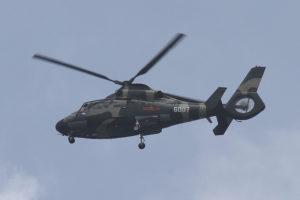 Kenya’s military had one of its biggest victories this past weekend when two of its helicopter gunships attacked an al Shabaab convoy in Southern Somalia, killing more than 100 militant fighters, according to Kenyan Military spokesman Emmanuel Chirchir. This comes after the January 21 announcement that Kenya’s military incursion passed the halfway point in its “battle to crush the al Qaeda-linked insurgency in southern Somalia.”
Kenya’s military had one of its biggest victories this past weekend when two of its helicopter gunships attacked an al Shabaab convoy in Southern Somalia, killing more than 100 militant fighters, according to Kenyan Military spokesman Emmanuel Chirchir. This comes after the January 21 announcement that Kenya’s military incursion passed the halfway point in its “battle to crush the al Qaeda-linked insurgency in southern Somalia.”
This conflict has raged on for months. Many hope that the Kenyan offensive in the South and the African Union (AU) force in Mogadishu will quell the violence and stabilize Somalia after years of death and destruction.
Al Shabaab announced a ‘tactical withdrawal’ from the Somalia capital in August after an offensive by AU and government forces.
The main players on the Kenyan side have to be the Americans and the French. In October, the US revealed that it has sold military equipment and offered logistical support and training, although this has been taking place for sometime now. The US is also supporting the AU mission in Somalia (AMISOM), providing drones, body armor and night vision capability.
This equipment has been put to good use. In Late January, an alleged al-Qaeda member from London was killed in a missile attack on his car from an American drone on the outskirts of Mogadishu.
France, like Washington, is also providing logistical support to Kenyan forces. Col Thierry Burkhard said in late 2011 that French planes would transport military equipment to Kenyan soldiers near the Somali border. However, he denied Kenyan military claims that a French warship had shelled a Somali town.
With the help of both the French and the US, the Kenyan military is definitely no Mickey Mouse fighting unit. The Kenyan Air Force is well-armed with F-5 Tiger Attack jets, MD-500 and Chinese-made Harbin Z-9 helicopters.

In early January, F5 air strikes killed at least 60 Al-Shabaab militants in southern Somalia. The combination of air strikes by the jets and attack helicopters has helped pave the way for the Kenyan army and their tanks and armored personnel carriers to advance. This includes Vickers Mk3s, T72s, Humvees and the South African Puma M26.
Al Shabaab, or the ‘Youth’ in Arabic, has been using guerrilla tactics to thwart the Kenyan firepower and they have been successful. Besides utilizing the typical terrorist group arsenal of AK-47’s, RPGs and hand grenades, they have become masters of the Improvised Explosive Device or IED.
A typical example of how Al Shabaab uses the IED is as follows: “when they need to target a suicide attack to its opponents, first they arrange a single person to carry out this attack as to be the suicide man, they put on his body a number of explosive belts and then they dress the person with the uniform of a TFG military soldier, which they are capable to find. They then load the vehicle with the explosive materials mostly containing eminent flammable items, and they also pack with the vehicle mixture of gun powder, car batteries, acids, a number of mobile phones, and sometimes a missile is put inside the vehicle to cause destructive power to the entire vehicle.”
Al Shabaab does have allies. First and foremost are their Yemeni counterparts, who recently shipped two boats loaded with military logistics, light weapons, Kalashnikovs and ammunition, and hand grenades. It is also believed to have the support of Eritrea, but this is something that the Eritrean government denies.
Sticks and stones may break my bones but words will never hurt me. This old saying might not ring true for Al Shabaab or does it? It is believed that al-Shabaab is losing political support in Somalia due to the famine and its preventing humanitarian aid from reaching those who desperately need it. There are also accusations of internal divisions within the al-Qaeda faction.
In retaliation, al-Shabaab is using a similar campaign of propaganda with the use of social media like twitter. They joined in December (@HSMPress) and now have over 10,000 followers. The Kenyan Defense Force joined about a month earlier, in November (see KDF spokesman Emmanuel Chirchir @MajorEChirchir who has over 21,000 followers). Al-Shabaab tries to persuade the Somalian people by saying Kenyan troops are violating the sovereignty of their country and that they are the main line of defense against the hostile foreign invaders.
The BBC’s East Africa correspondent Will Ross says it is increasingly hard to know who is telling the truth in what is a hard-fought propaganda war (http://www.bbc.co.uk/news/world-africa-15559584). And this will not change over the coming months.
Photo 1- Courtesy of Reuters (Al Shabaab militants parade new recruits after arriving in Mogadishu October 21, 2010, from their training camp south of the capital of Somalia). Available at: http://www.ibtimes.com/articles/235664/20111021/at-least-10-peacekeepers-killed-in-somalia-battle.htm
Photo 2- Courtesy of Daryl Chapman, Bauhinia Photography (Z9 Helicopter, taken on July 6th, 2010). Available at: http://www.flickr.com/photos/darylchapman/4768078868/